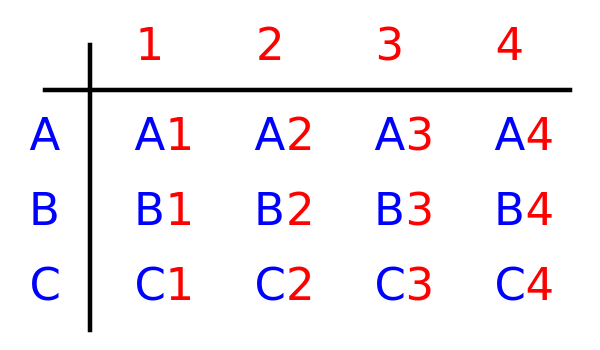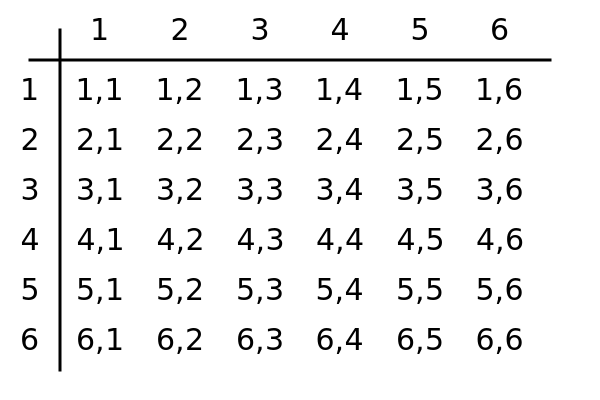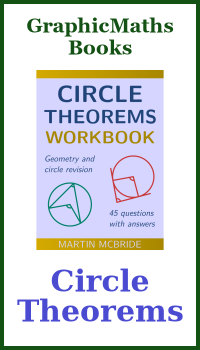Cartesian product
Categories: statistics probability

The Cartesian product of two sets includes every possible combination of an element from the first set and an element from the second set.
Example
Suppose you had two sets of cards:
- 3 red cards marked A, B and C
- 4 blue cards numbered 1 to 4
The Cartesian product shows all the possible combinations of a red card and a blue card:

The grid shows all the possible pairs of values.
Calculating probabilities
The Cartesian product can be useful for calculating probabilities. This table shows all possible results of throwing two dice:

It shows every possibility for the first and second dice scores. Here is another table that shows the sum of the scores:

This can be used, for example, to determine the probability that the total score will be 5. There are 4 possible pairs of values that add up to 5, out of 36 possible pairs in total. This means that the probability of scoring 5 is 4/36, or 1 in 9.
More dimensions
If there are more than two values, for example if 3 dice were thrown, the result would be a 3-dimensional table of 6 by 6 by 6 entries. This can be extended to any number of dimensions, although it becomes less useful because it is hard to visualise.
Related articles
Join the GraphicMaths Newsletter
Sign up using this form to receive an email when new content is added to the graphpicmaths or pythoninformer websites:

Popular tags
adder adjacency matrix alu and gate angle answers area argand diagram binary maths cardioid cartesian equation chain rule chord circle cofactor combinations complex modulus complex numbers complex polygon complex power complex root cosh cosine cosine rule countable cpu cube decagon demorgans law derivative determinant diagonal directrix dodecagon e eigenvalue eigenvector ellipse equilateral triangle erf function euclid euler eulers formula eulers identity exercises exponent exponential exterior angle first principles flip-flop focus gabriels horn galileo gamma function gaussian distribution gradient graph hendecagon heptagon heron hexagon hilbert horizontal hyperbola hyperbolic function hyperbolic functions infinity integration integration by parts integration by substitution interior angle inverse function inverse hyperbolic function inverse matrix irrational irrational number irregular polygon isomorphic graph isosceles trapezium isosceles triangle kite koch curve l system lhopitals rule limit line integral locus logarithm maclaurin series major axis matrix matrix algebra mean minor axis n choose r nand gate net newton raphson method nonagon nor gate normal normal distribution not gate octagon or gate parabola parallelogram parametric equation pentagon perimeter permutation matrix permutations pi pi function polar coordinates polynomial power probability probability distribution product rule proof pythagoras proof quadrilateral questions quotient rule radians radius rectangle regular polygon rhombus root sech segment set set-reset flip-flop simpsons rule sine sine rule sinh slope sloping lines solving equations solving triangles square square root squeeze theorem standard curves standard deviation star polygon statistics straight line graphs surface of revolution symmetry tangent tanh transformation transformations translation trapezium triangle turtle graphics uncountable variance vertical volume volume of revolution xnor gate xor gate
